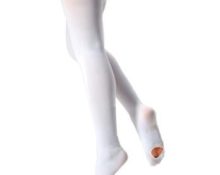Due to its effectiveness, compression knitwear is becoming increasingly in demand. Special stockings can prevent many diseases, as well as significantly alleviate the patient’s condition. Read on to learn more about the features of compression and anti-embolic products, as well as their similarities and differences between them.
What are anti-embolic stockings?
 Anti-embolic stockings are one of the types of therapeutic knitwear. They are also called hospital knitwear, because in most cases they are used before or during operations and under the strict supervision of the attending physician.
Anti-embolic stockings are one of the types of therapeutic knitwear. They are also called hospital knitwear, because in most cases they are used before or during operations and under the strict supervision of the attending physician.
Elastic underwear provides even pressure on the legs, and from the ankles to the thigh it decreases. Due to this, active blood flow is formed and the likelihood of thrombosis is reduced. Wearing is recommended for those patients who remain immobile for a long time..
Important! Men's and women's product models differ only in size.
Compression stockings - what kind of wardrobe item?
 Compression models can be used for long and constant wear. That's why they are often called everyday. Wearing this item of clothing is one of the ways to influence the human venous system. Stockings can help with the problem of leg swelling and prevent the development of varicose veins. The product is made in such a way that pressure is applied specifically to problem areas.
Compression models can be used for long and constant wear. That's why they are often called everyday. Wearing this item of clothing is one of the ways to influence the human venous system. Stockings can help with the problem of leg swelling and prevent the development of varicose veins. The product is made in such a way that pressure is applied specifically to problem areas.
Attention! Due to the pressure of the stockings on the legs, the diameter of the expanded legs decreases.
How are they similar?
Compression and anti-embolic models have certain similarities with each other:
 they have different compression classes and create a certain pressure on the legs;
they have different compression classes and create a certain pressure on the legs;- stimulate the flow of blood from the legs towards the heart;
- they are selected depending on the required degree of compression, taking into account the individual parameters of a person.
What is the difference between anti-embolic and compression stockings?
There are much more requirements for hospital knitwear compared to compression garments. We list the main parameters by which these products differ:
 Time of use. Anti-embolic products can be worn for 5–6 days after delivery and up to 2 weeks in the postoperative period. Compression garments can be worn constantly.
Time of use. Anti-embolic products can be worn for 5–6 days after delivery and up to 2 weeks in the postoperative period. Compression garments can be worn constantly.- Hospital knitwear is sewn only in white. This allows the doctor to control the color of the patient’s skin and monitor discharge from wounds. Everyday products can have a variety of colors.
- Ability to withstand high temperatures. Hospital-type products must be sanitized in a timely manner. That's why they can withstand frequent washing and high temperatures without compromising the texture of the stockings. Also, unlike compression ones, they can easily withstand sterilization in an autoclave.
- Hypoallergenicity of anti-embolic items is a prerequisite, unlike compression ones. This is because the use of medications increases the risk of allergies.
Reference! Models for everyday wear are made of very thin knitwear and require careful washing. In order not to spoil the structure of the fibers, they should not be wrung out or twisted.
It is necessary to select clothing of this type wisely, taking into account the degree of compression and size. Before purchasing, it is advisable to consult with your doctor or orthopedic specialist.. It is necessary to remember that for long-term wearing you should purchase everyday stockings, and when preparing for surgery or childbirth - hospital stockings.


 they have different compression classes and create a certain pressure on the legs;
they have different compression classes and create a certain pressure on the legs; Time of use. Anti-embolic products can be worn for 5–6 days after delivery and up to 2 weeks in the postoperative period. Compression garments can be worn constantly.
Time of use. Anti-embolic products can be worn for 5–6 days after delivery and up to 2 weeks in the postoperative period. Compression garments can be worn constantly. 0
0






I had surgery on my ureter. The doctor requires me to wear anti-embolic stockings for 2 weeks. Why so long?